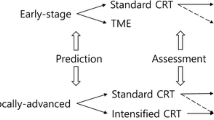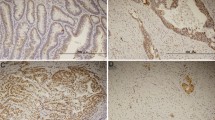Abstract
Background
Preoperative chemoradiotherapy (CRT) significantly decreases local recurrence in patients with rectal cancer. Although various biomarkers in biopsy specimens obtained before starting CRT have been examined, reliable prognostic factors have yet to be established. We tested the hypothesis that biopsy specimens obtained soon after the start of CRT can be used as prognostic factors.
Methods
Preoperative CRT was given to 70 consecutive patients with rectal cancer. Biopsies were taken before and about 7 days after starting CRT. The specimens were stained with hematoxylin and eosin (HE), and the expressions of Ki67, p53, and p21 and apoptosis were evaluated immunohistochemically.
Results
The expressions of Ki67, p53, and p21 and apoptosis before treatment were not significantly related to histologic response or tumor shrinkage. In specimens obtained about 7 days after CRT began, marked histologic regression was significantly higher in p21-positive, apoptosis-positive cases, and in cases with moderate changes on HE specimens (p = 0.017, p = 0.010, and p = 0.004, respectively). The tumor shrinkage was significantly higher in apoptosis-positive cases and cases with moderate changes on HE specimens (p = 0.002 and p < 0.001, respectively). Disease-free survival (DFS) was significantly higher in patients who had marked regression than in those who did not (p = 0.019). DFS was also significantly higher in patients with moderate changes on HE specimens than in those with mild changes (p = 0.016).
Conclusions
Changes on HE-stained biopsy specimens obtained about 1 week after starting CRT are a reliable prognostic factor, similar to histologic marked regression in resected specimens; a major advantage is that the former results are available at an early phase.



Similar content being viewed by others

References
Peeters KC, Marijnen CA, Nagtegaal ID et al (2007) The TME trial after a median follow-up of 6 years: increased local control but no survival benefit in irradiated patients with resectable rectal carcinoma. Ann Surg 246:693–701
Sauer R, Liersch T, Merkel S et al (2012) Preoperative versus postoperative chemoradiotherapy for locally advanced rectal cancer: results of the German CAO/ARO/AIO-94 randomized phase III trial after a median follow-up of 11 years. J Clin Oncol 30:1926–1933
Bosset JF, Collette L, Calais G et al (2006) Chemotherapy with preoperative radiotherapy in rectal cancer. N Engl J Med 355:1114–1123
Gerard JP, Conroy T, Bonnetain F et al (2006) Preoperative radiotherapy with or without concurrent fluorouracil and leucovorin in T3-4 rectal cancers: results of FFCD 9203. J Clin Oncol 24:4620–4625
Sadahiro S, Suzuki T, Ishikawa K et al (1999) Development of an irradiation method of intraoperative radiation therapy for curatively resected rectal cancer. Int J Clin Oncol 4:210–214
Sadahiro S, Suzuki T, Ishikawa K et al (2001) Intraoperative radiation therapy for curatively resected rectal cancer. Dis Colon Rectum 44:1689–1695
Sadahiro S, Suzuki T, Ishikawa K et al (2004) Preoperative radio/chemo-radiotherapy in combination with intraoperative radiotherapy for T3-4Nx rectal cancer. Eur J Surg Oncol 30:750–758
Maas M, Nelemans PJ, Valentini V et al (2010) Long-term outcome in patients with a pathological complete response after chemoradiation for rectal cancer: a pooled analysis of individual patient data. Lancet Oncol 11:835–844
de Campos-Lobato LF, Stocchi L, da Luz Moreira A et al (2010) Downstaging without complete pathologic response after neoadjuvant treatment improves cancer outcomes for cIII but not cII rectal cancers. Ann Surg Oncol 17:1758–1766
Park IJ, You YN, Agarwal A et al (2012) Neoadjuvant treatment response as an early response indicator for patients with rectal cancer. J Clin Oncol 30:1770–1776
Rodel C, Grabenbauer GG, Papadopoulos T et al (2002) Apoptosis as a cellular predictor for histopathologic response to neoadjuvant radiochemotherapy in patients with rectal cancer. Int J Radiat Oncol Biol Phys 52:294–303
Kuremsky JG, Tepper JEMcLeod HL (2009) Biomarkers for response to neoadjuvant chemoradiation for rectal cancer. Int J Radiat Oncol Biol Phys 74:673–688
Spolverato G, Pucciarelli S, Bertorelle R et al (2011) Predictive factors of the response of rectal cancer to neoadjuvant radiochemotherapy. Cancers (Basel) 3:2176–2194
Nakano TOka K (1991) Transition of Ki-67 index of uterine cervical tumors during radiation therapy. Immunohistochemical study. Cancer 68:517–523
JSCCR. Japanese society for cancer of the colon and rectum (1997) Japanese classification of colorectal carcinoma, 1st edn. Kanehara, Tokyo
Mandard AM, Dalibard F, Mandard JC et al (1994) Pathologic assessment of tumor regression after preoperative chemoradiotherapy of esophageal carcinoma. Clinicopathologic correlations. Cancer 73:2680–2686
Suzuki T, Sadahiro S, Fukasawa M et al (2004) Predictive factors of tumor shrinkage and histological regression in patients who received preoperative radiotherapy for rectal cancer. Jpn J Clin Oncol 34:740–746
Reerink O, Karrenbeld A, Plukker JT et al (2004) Molecular prognostic factors in locally irresectable rectal cancer treated preoperatively by chemo-radiotherapy. Anticancer Res 24:1217–1221
Scholzen TGerdes J (2000) The Ki-67 protein: from the known and the unknown. J Cell Physiol 182:311–322
Kim NK, Park JK, Lee KY et al (2001) p53, BCL-2, and Ki-67 expression according to tumor response after concurrent chemoradiotherapy for advanced rectal cancer. Ann Surg Oncol 8:418–424
Kikuchi M, Mikami T, Sato T et al (2009) High Ki67, Bax, and thymidylate synthase expression well correlates with response to chemoradiation therapy in locally advanced rectal cancers: proposal of a logistic model for prediction. Br J Cancer 101:116–123
Jakob C, Liersch T, Meyer W et al (2008) Predictive value of Ki67 and p53 in locally advanced rectal cancer: correlation with thymidylate synthase and histopathological tumor regression after neoadjuvant 5-FU-based chemoradiotherapy. World J Gastroenterol 14:1060–1066
Huerta S, Hrom J, Gao X et al (2010) Tissue microarray constructs to predict a response to chemoradiation in rectal cancer. Dig Liver Dis 42:679–684
Chang HJ, Jung KH, Kim DY et al (2005) Bax, a predictive marker for therapeutic response to preoperative chemoradiotherapy in patients with rectal carcinoma. Hum Pathol 36:364–371
Willett CG, Warland G, Hagan MP et al (1995) Tumor proliferation in rectal cancer following preoperative irradiation. J Clin Oncol 13:1417–1424
Namba H, Hara T, Tukazaki T et al (1995) Radiation-induced G1 arrest is selectively mediated by the p53-WAF1/Cip1 pathway in human thyroid cells. Cancer Res 55:2075–2080
Lowe SW, Ruley HE, Jacks T et al (1993) p53-dependent apoptosis modulates the cytotoxicity of anticancer agents. Cell 74:957–967
Fan S, el-Deiry WS, Bae I et al (1994) p53 gene mutations are associated with decreased sensitivity of human lymphoma cells to DNA damaging agents. Cancer Res 54:5824–5830
Lin LC, Lee HH, Hwang WS et al (2006) p53 and p27 as predictors of clinical outcome for rectal-cancer patients receiving neoadjuvant therapy. Surg Oncol 15:211–216
Cascinu S, Graziano F, Catalano V et al (2002) An analysis of p53, BAX and vascular endothelial growth factor expression in node-positive rectal cancer. Relationships with tumour recurrence and event-free survival of patients treated with adjuvant chemoradiation. Br J Cancer 86:744–749
Bertolini F, Bengala C, Losi L et al (2007) Prognostic and predictive value of baseline and posttreatment molecular marker expression in locally advanced rectal cancer treated with neoadjuvant chemoradiotherapy. Int J Radiat Oncol Biol Phys 68:1455–1461
Rau B, Sturm I, Lage H et al (2003) Dynamic expression profile of p21WAF1/CIP1 and Ki-67 predicts survival in rectal carcinoma treated with preoperative radiochemotherapy. J Clin Oncol 21:3391–3401
Negri FV, Campanini N, Camisa R et al (2008) Biological predictive factors in rectal cancer treated with preoperative radiotherapy or radiochemotherapy. Br J Cancer 98:143–147
Edden Y, Wexner SDBerho M (2012) The use of molecular markers as a method to predict the response to neoadjuvant therapy for advanced stage rectal adenocarcinoma. Colorectal Dis 14:555–561
el-Deiry WS, Harper JW, O’Connor PM et al (1994) WAF1/CIP1 is induced in p53-mediated G1 arrest and apoptosis. Cancer Res 54:1169–1174
Charara M, Edmonston TB, Burkholder S et al (2004) Microsatellite status and cell cycle associated markers in rectal cancer patients undergoing a combined regimen of 5-FU and CPT-11 chemotherapy and radiotherapy. Anticancer Res 24:3161–3167
Sogawa N, Takiguchi N, Koda K et al (2002) Value of expression of p21WAF1/CIP1 as a prognostic factor in advanced middle and lower rectal cancer patients treated with preoperative radio-chemotherapy. Int J Oncol 21:787–793
Garrity MM, Burgart LJ, Mahoney MR et al (2004) Prognostic value of proliferation, apoptosis, defective DNA mismatch repair, and p53 overexpression in patients with resected Dukes’ B2 or C colon cancer: a North Central Cancer Treatment Group Study. J Clin Oncol 22:1572–1582
Berger C, de Muret A, Garaud P et al (1997) Preoperative radiotherapy (RT) for rectal cancer: predictive factors of tumor downstaging and residual tumor cell density (RTCD): prognostic implications. Int J Radiat Oncol Biol Phys 37:619–627
Conflict of interest
The authors declare that they have no conflict of interest.
Author information
Authors and Affiliations
Corresponding author
About this article
Cite this article
Suzuki, T., Sadahiro, S., Tanaka, A. et al. Predictive markers of chemoradiotherapy for rectal cancer: comparison of biopsy specimens taken before and about 1 week after the start of chemoradiotherapy. Int J Clin Oncol 20, 1130–1139 (2015). https://doi.org/10.1007/s10147-015-0822-7
Received:
Accepted:
Published:
Issue Date:
DOI: https://doi.org/10.1007/s10147-015-0822-7



